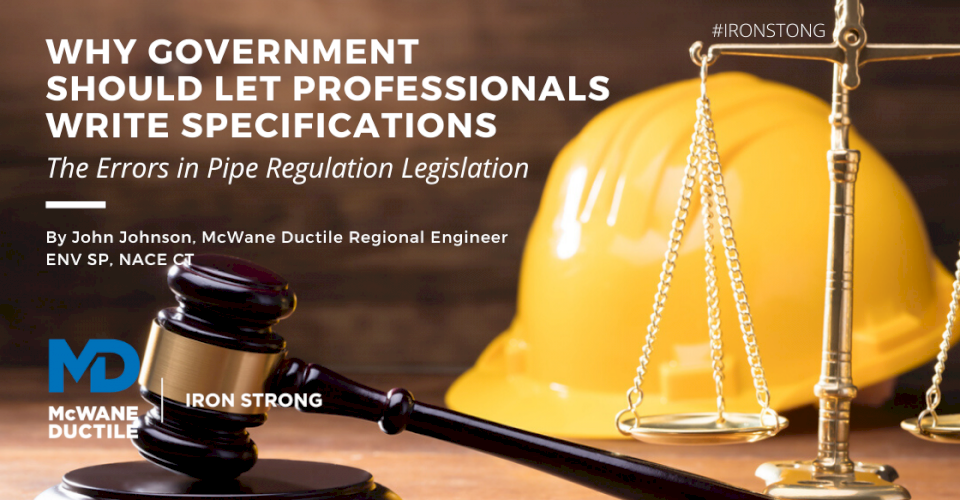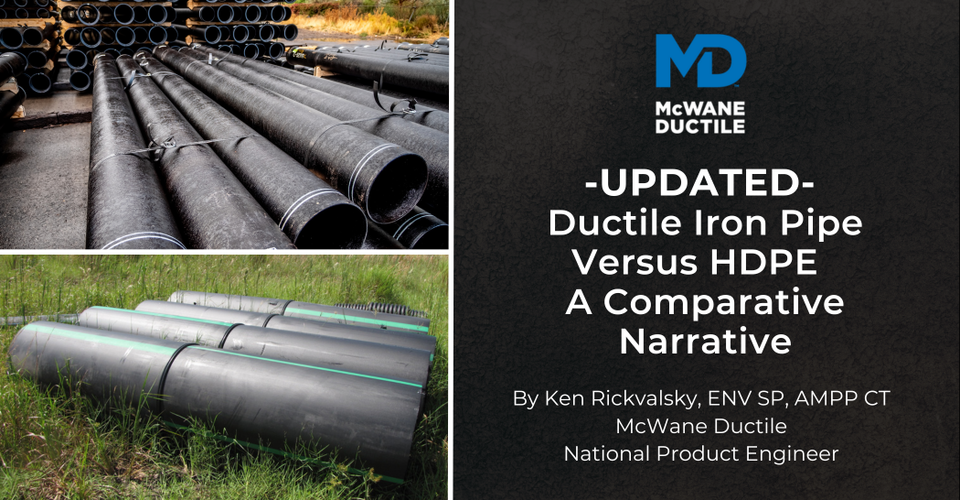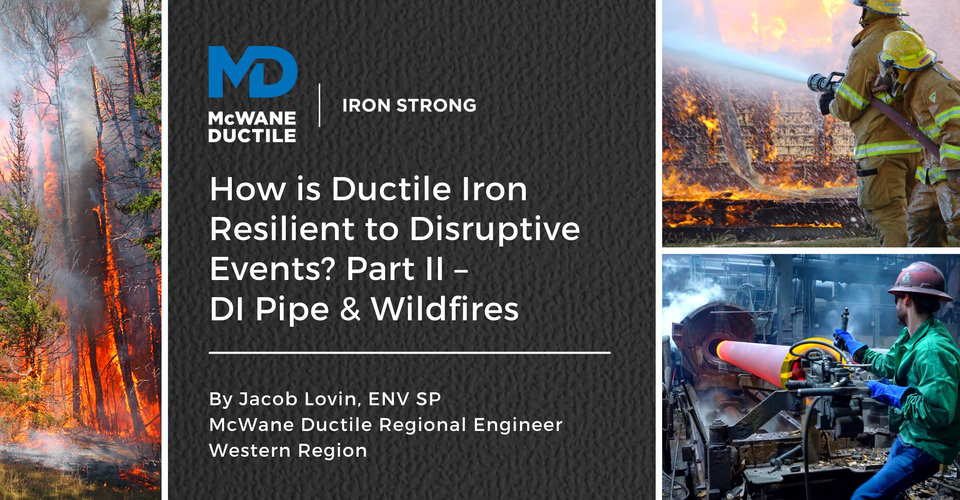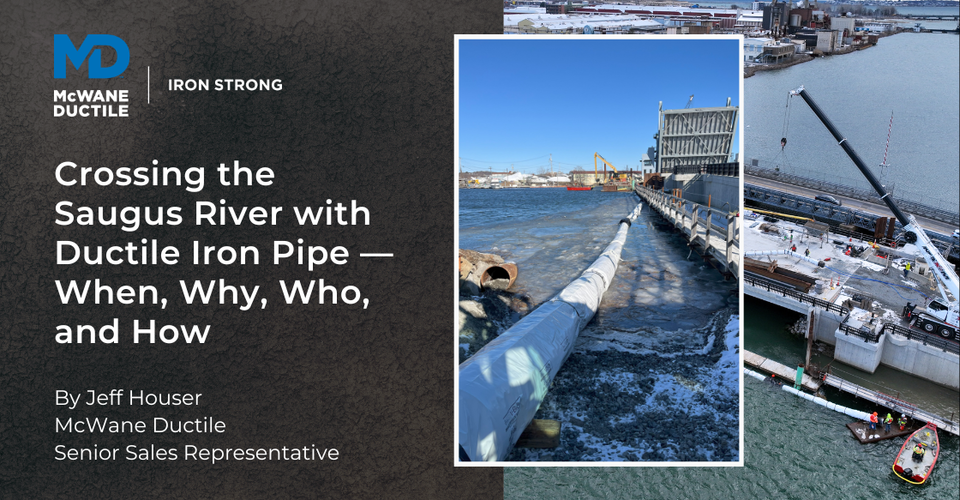Recently, there have been multiple unsuccessful attempts by plastic pipe manufacturers and their trade associations to have legislation passed, mostly on the state level, requiring utilities to specify plastic pipes on their projects.
This legislation is a subject worth exploring deeper as it is being promoted by supporters of plastic and their lobbyists as a fiscally responsible requirement. Still, it provides no consideration for the many variables required in material selection or pipeline design; all are completely ignored in the proposed legislation which would ultimately be an "initial price only" comparison.
Let's Take A Look At Some of These Factors:
- Evolved pipeline design and material selection account for long term pipe performance, or how long you plan for the piping system to last.
- Evolved pipeline design and material selection account for long term pipe performance to maximize the design life goals.
- Evolved pipeline design and material selection consider the operational costs of the pipeline system.
- Evolved pipeline design and material selection consider the Lifecycle Costs of the pipeline project, not just initial material costs.
- Evolved pipeline design and material selection consider the resiliency of the system, utilizing a robust design & pipe material.
- Suitable pipeline design and material selection consider the environment & sustainability.
- Proper pipeline design and material selection account for local conditions as well as the methods of installation.
As a utility or consulting engineer, I am guessing you would agree that these factors and many others are critical in designing pipelines and selecting pipe materials. You know the local challenges. All licensed and certified professionals, utility operators, managers, designers, and engineers ethically consider these factors. Do politicians? Or do they give preference to those who provide campaign contributions or apply lobbying pressure?
Is This Approach to Legislating Pipe Materials New?
Unfortunately, it is not. In the early 1900s, as lead pipe was still in use but starting to be replaced by other metals like iron and copper, the lead pipe industry undertook a similar approach to have lead pipe required to be included in municipal pipe specifications.
I would suspect most people know how that worked out in Flint, Michigan, but it is doubtful few of those politicians are still around to be held accountable for those choices. It also was not just lead pipe but also pipe made with asbestos (A/C). While no studies have shown asbestos fibers consumed in drinking water are harmful…what rate-payer would not object to having asbestos in their glass of water?
Additionally, a comprehensive study of airborne asbestos fibers in homes being served by asbestos pipe has never been done. Still, it would be common sense to expect asbestos fibers from deteriorating pipe to become airborne via shower and cooking steam, embedded in laundries such as sheets and towels, and more. Perhaps a reminder of those consequences is in order.
Here Is A List of Lead Pipe Specification Stories to Consider:
- The Lead Industry and Lead Water Pipes “A MODEST CAMPAIGN”
- “Lead pipes for carrying drinking water were well recognized as a cause of lead poisoning by the late 1800s in the United States…… Led by the Lead Industries Association (LIA), representatives were sent to speak with plumbers’ organizations, local water authorities, architects, and federal officials.”
- The banning of Lead pipe did not occur until 1986.
- “Who should be responsible for replacing Pittsburgh’s lead water pipes?”
- "As Other Cities Dig Up Pipes Made of Toxic Lead, Chicago Resists"
- “A Brief History of How the American Public Was Sold on Toxic Lead
- How We Ended Up with Lead Piping and Why Removing It Will Be Hard
I Agree, But What Can I Do About It?
As many of you are reading this, you may be thinking, “I completely agree, but what can I do about it?” Well, these links will help you contact the right people to voice your opposition to such activity. As a preventative measure, you may even want to consider alerting your legislators before this becomes an issue for you. Here are links providing helpful information to guide you:
- https://dipra.org/government-affairs/local-choice
- https://dipra.org/government-affairs/write-your-representative
For those looking for more depth to this discussion, let us continue.
Long-Term Performance – Proposed Legislation Includes No Provisions for Life Expectancy.
Who wouldn’t be concerned with long-term performance when it comes to designing utility systems? In the early 1900s when today's 100+-year-old pipe was installed, typical design life was 50 years or less. Today’s utilities are faced with systems that are twice the age of their design life.
One of the primary water utility design textbooks copyrighted in 2008 titled “Design of Water Supply Pipe Networks” goes into depth on the importance of design life. It is worth noting that in reference to other publications, the authors state iron pipe has a 120-year life expectancy and 60 years for plastic and asbestos cement pipes. The authors also provide formulas for calculating the design period based on pipe material life expectancy.
Furthermore, AWWA’s publication “Buried No Longer – Confronting America’s Water Infrastructure Challenge” shows the importance of considering long term performance in pipe selection and design. For a very in-depth blog covering the details of this publication, see this Iron Strong Blog by my colleague, Roy Mundy, P.E., ENV SP, Assoc. DBIA, McWane Ductile Senior Regional Engineer.
Ductile iron pipe (DI pipe) from McWane Ductile can provide over 100 years of unrelenting, high-level performance! This performance is proven by more than 560 utilities throughout North America that have iron pipe still in service that’s over 100 years old as well as many over 150 years old. Additionally, iron pipe had served the fountains of Versailles, France, for more than 300 years.
Cost of Operating Your Pipeline System – Shouldn’t It Be Considered in The Design of Pipelines and Selection of Pipe Materials?
Simply stated, who wouldn’t? Consideration of operating costs needs to be done through an analysis of several factors such as pumping costs, tapping costs, and, in the case of possible damage from other construction, destruction or calamity, repair costs.
Pumping costs are based on the energy needed to push water or other liquids through the pipeline. Most utilities show energy costs to be their highest single operating cost after personnel. Comparisons of energy costs required for pumping can easily be calculated using the Energy Savings Calculator of the McWane Pocket Engineer
Tapping costs for services or future connections can be extremely different for different pipe materials, both in equipment and procedures. DI pipe can be easily direct tapped for most service connections with simple equipment most utilities possess while some piping materials need expensive specialized equipment, fusion machines, and tapping saddles.
Additionally, DI pipe is easily and quickly tapped with minimal equipment wear and tear due to the graphite content in the iron matrix.
Repair Costs are a factor we would hope would not need to be considered, but an extensive system study by a major northeastern U.S. coastal city found that the majority of their main breaks were actually the result of separate post-installation construction damage even on mains over 100 years old. As a result, for them, their design criteria became the pipe with the most significant overall damage resistance, not surprisingly, DI pipe is their standard.
Another example of a utility specifying DI pipe to replace failing infrastructure was in the case of the Consolidated Utility District (CUD) in Murfreesboro, Tennessee. See this Iron Strong Blog, where Bill Dunnill, GM of CUD tells why they chose Ductile iron over alternate materials.
Life Cycle Cost and Asset Management Go Hand-in-Hand
All properly managed utility systems are concerned with the actual cost of the system over its entire life or its lifecycle cost. It is as much a part of Asset Management in today’s utility as water chemistry is to water quality.
As we now know, today’s cost of a material can often be insignificant compared to the total cost of ownership over its life. We consider this lifecycle cost when we make purchasing decisions on everything from cars to appliances and electronics and homes.
When it comes DI pipe, the lifecycle cost is one of its most significant benefits. Since it lasts for generations, it is economical to operate, is easily and efficiently installed and operated, its long term or lifecycle cost is comfortably lower than any other material.
The University of Michigan published a study on pipe lifecycle cost.
If you would like to have an actual lifecycle cost analysis done for your project, McWane Ductile’s Engineers can help you with those calculations.
Should Resiliency Be Considered in Pipeline Design?
Resiliency, when discussing water systems, has become an even more important topic considering recent catastrophic events. Maintaining or returning water system service as quickly as possible is essential to communities to fight fires and save lives. Lack of resiliency in pipe design and material selection has become dangerously evident from wildfires in California.
Additionally, seismic activity, unstable slopes, and soils are also a concern in many areas. U.S. standards are being developed to address those concerns aided by testing research conducted at Cornell University and the University of Colorado-Boulder among others. Ductile iron pipe is currently the only material standardized by the International Organization for Standardization due to its robust design and proven resilience in earthquake-prone areas.
Environment – Is It Something You and Your Utility Care About?
Wouldn't it make sense for environmental concerns, including recyclability and recycled content, to be a consideration for selecting materials when possible? Wouldn't it make sense for your utility to be able to exclude materials that contain or consist of inherently unhealthy substances such as asbestos, lead, vinyl chloride, and other carcinogens and endocrine disruptors?
Questions That Should Be Asked Are:
- Is it made of recycled material?
- Is it easily recycled?
- Is it not made of carcinogenic substances?
- Does it not create carcinogenic by-products as a result of its manufacturing process or through the manufacturing of its raw material?
- Does it have a smaller carbon footprint than other materials and require less net embodied energy than other materials?
Choosing pressure pipe available with these attributes would seem to be another sensible requirement for any proposed legislation yet is conspicuously absent. Meeting such a condition is easily recognized via SMaRT certification from the Institute for Market Transformation to Sustainability's ("MTS"). Leadership in Energy and Environmental Design (LEED) or ENVISION (from the Institute of Sustainable Infrastructure) certification should also be a component of pipeline design and pipe selection.
To see how Ductile iron pipe from McWane Ductile can help you meet your environmental and sustainability goals, contact one of our ENVISION Accredited Professionals.
With Property, Location is Key to Proper Installation
Conditions of installation, as well as the methods of installation, can vary greatly, not only from one utility to another but also from one project to another. Highly congested urban environments contain higher damage risks from unrelated nearby construction as opposed to rural pipelines in dry areas having high susceptibility to wildfires.
Pipelines constructed along seismic fault lines face different hazards than pipelines built in flat sandy coastal areas as do pipelines in mountainous regions. Pressure zones and ranges can vary significantly in systems, and surge pressures can be even more of a factor. Unstable soils are very different from areas consisting of mostly volcanic rock.
To Summarize
In summary, we encourage you to contact your local legislative representative to discuss the importance of having the ability to specify the correct materials for your water and wastewater projects. All of the factors mentioned above, along with many others need to be and are considered by utility and design professionals on piping projects on a daily basis but are beyond the scope of the thought processes of a politician when considering “initial price only” legislation.
Need Assistance with Your Waterworks Project?
If you have any questions or need additional information, please feel free to contact your local McWane Ductile Representative. We have team members who’ve managed small and large water utility systems, served in engineering consulting firms, and bring decades of experience in solving field issues involving pipeline construction and operation. From design to installation, we take great pride in providing education and assistance to water professionals throughout the water and wastewater industry.
















